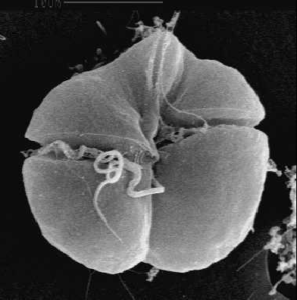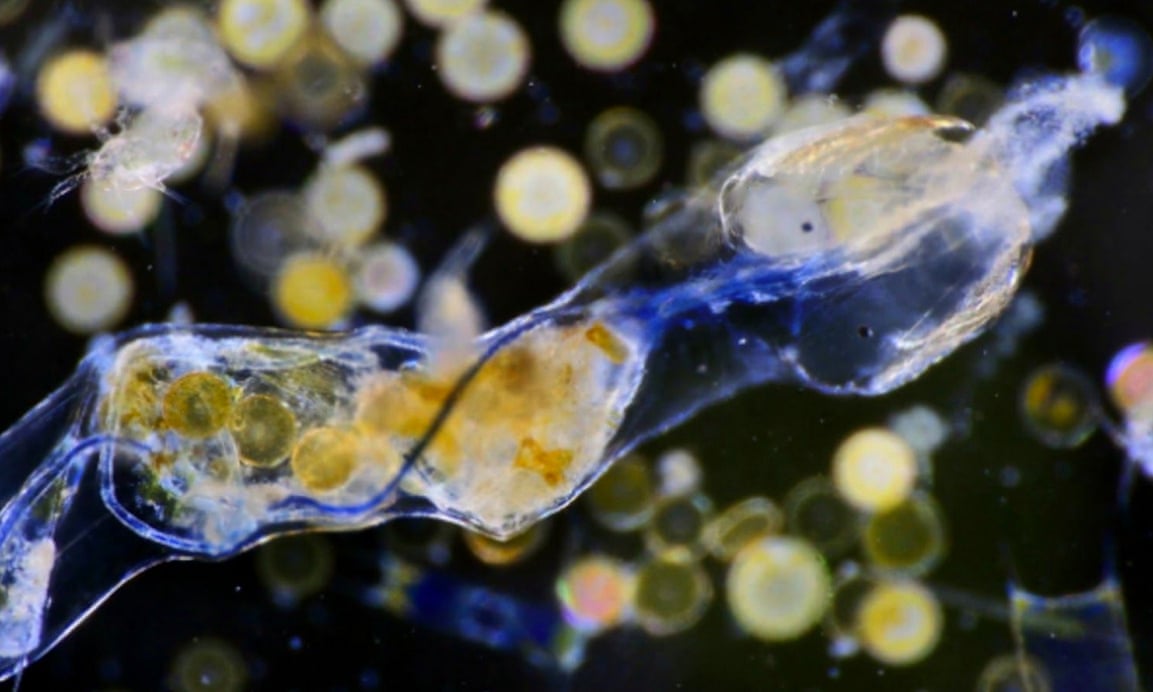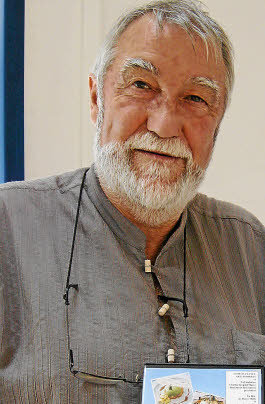Interview with Pierre Mollo, member of Iodysseus’ scientific team.
How plankton can influence the direct weather by creating rain. How it impacts our daily life. How the decreasing population of diatoms (a type of micro-algae) or the increasing populations of dinoflagellates or cyanobacteria may threaten our health in the near future. Why the worst impacts of plastic pollution in the oceans are not the ones we see in the media. Lastly, why the Iodysseus program is working on issues concerning the planet’s global ecosystem. Answers from Pierre Mollo, lecturer/researcher and marine biologist.
Every human being has saltwater in his or her veins: plasma, a reminder of our marine origins. Some, however, have more than others—Pierre Mollo, for example. Raised in Port-Louis (Morbihan department, region of Brittany), he grew up eating godaille, the leftover fish given to fishermen. His grandfather and other elderly folks called it “the bread of the sea”. Nothing would keep young Pierrot from dedicating his life to it. In 1969, at the age of 21, he quit his factory job. His goal: travel to Japan. He remembers: “The Japanese were 20 years ahead of us in terms of marine biology, micro-algae cultures, phyto- and zooplankton.” The knowledge he gathered was useful to the fishermen in Houat, as well as marine-related fields. As teaching material was scarce, he supplemented his studies with Anita Conti’s book L’Océan, les bêtes et l’homme (Ocean, Animals and Man). He also met “the lady of the sea” personally. His commitment to plankton has led him to work to inform and alert the public to the cause. Through conferences, films, and books, Pierre Mollo sheds light on the “ecology of the invisible”—the universe of microorganisms that are necessary to our planet’s biology. He earned a Ph.D in ethnology, then turning to research and becoming an ambassador to the “little people of the sea”. Ever humble, he continues to introduce himself as a marine biologist, still devoted to his beloved island of Houat (Morbihan, Brittany). Pierre Mollo founded the Plankton Observatory in his hometown of Port-Louis; the observatory is dedicated to the prevention of health risks caused by decreasing plankton biodiversity—which has already begun. Pierre is also a music lover; he was recently the inspiration for and co-writer of a symphony called La Voix des océans (The Voice of the Oceans), an ode to marine life. He was also the source of inspiration for the Iodysseus project, along with skipper Eric Defert. Pierre Mollo joined our scientific team. He is our Voice of the Oceans.
Iodysseus - Among all services provided to the planet and its inhabitants, the ocean and plankton ecosystems absorb 25 to 30% of emitted CO2 and produce 50% of our oxygen in exchange, according to current estimates. You claim that these numbers are even higher. Why?
Pierre Mollo – Phytoplankton—micro-algae—form a sort of “transparent prairie”, an area immeasurably bigger than the Earth’s total land mass. Like forests, they require three elements: light, mineral salts, and CO2, which they transform into oxygen. CO2 is heavier than our atmosphere, so why wouldn’t it fall into the ocean two thirds of the time, seeing as the ocean covers 70% of the planet’s surface? Are winds—whose importance I won’t deny—diverting CO2 over the continents, en masse? I contend that the oceans and phytoplankton absorb 70% of carbon dioxide, based on their surface area. The oceans may only trap a part of this percentage, over the long term, but that’s another story. If we imagine that the Earth has two lungs, the oceanic lung is the most predominant. In short, plankton are the ones who decide whether we have sunny or rainy weather, as stated by Guy Jacques, and this has been the case for the past 3.5 billion years. We are living on planet Plankton.
Iodysseus - Sunny or rainy weather? Are you referring to the role of plankton in regulating the atmosphere and climate?
Clouds are not made up of water vapor alone. They are seeded by particles like bacteria and other microorganisms that end up in the rain that falls on us. This means that every time that we act in a way that impacts the ocean, it will sooner or later come back to us, since everything happens in cycles. For me, to study plankton is to predict the future. Nowadays I work with students on an Erasmus+ program for the Likès middle and high schools in Quimper. These students will be 50 years old in the year 2050. And 50 years ago, I was in their shoes, just coming back from Japan where I had been introduced to aquaculture. The question I asked then, and am still asking now, is: how will phytoplankton and zooplankton provide us with proteins in the 2000s? When the world’s population reaches nine or ten billion people, plant resources will be insufficent due to a lack of space. Our goal is to find marine proteins to feed humanity—provided that we can harvest them in a sustainable way. Additionally, we aim to put an end to such nonsense as using 5 to 10 kg of fish flour to produce a single kilogram of tasteless, factory-farmed fish. Aquaculture can—and must—serve the resource, and not the other way around. It was this belief that pushed us to launch repopulation campaigns and establish the Houat fishery in the 1970s. At the time, I was employed by the fishermen’s cooperative to study the links and interactions between plankton and other marine organisms.
Iodysseus - Can you briefly explain these links?
It’s quite simple. The first condition is biodiversity at the water’s surface; everything begins with the richness and diversity of phytoplankton. If this diversity decreases, zooplankton diversity decreases as well, as does the diversity of larvae, fry, and so on—all the way up the food chain. Basically, resources are being depleted. In the plankton ecosystem, everything is linked: biodiversity, resources, and the complex equilibrium of the global system and the climate. Today, marine biologists are observing a decrease in plankton diversity. Looking back through sediment records, we observe a decrease in plankton populations, and major extinctions are the signs of critical phases in Earth’s history. For example, during a previous period of intense warming 56 million years ago, the Arctic Ocean was totally free of ice. Like tomorrow, once more, the answer is plankton biodiversity.
Iodysseus - You have been studying this biodiversity for approximately half a century. In concrete terms, how are things progressing here in Brittany?
Pierre Mollo – Poorly. One recent indication, among others: last summer (2018), swimming was forbidden on beaches in southern Finistère due to red tides. Personally, I don’t remember this ever occurring before. Green tides, yes, but that’s another story. The cause of these red tides is a dinoflagellate which is, luckily, not directly harmful to humans. Noctiluca scintillans is mainly known for the bluish sparkles it emits, visible in waves and in the wakes of passing vessels. However, its proliferation is far from insignificant. 50 years ago, when I was working in Houat, finding one unique dinoflagellate under the microscope was a miracle: I called my friends over. “Come and see! I found one!” At the time, diatoms were the most predominant. Today, when I return to Houat, I find dinoflagellates every time, and in increasing number. In this phylogenetic class of 2400 species of archaic phytoplankton, not all of them photosynthesize organic matter. Some feed on other phytoplankton as a food source. This is the case with Noctiluca scintillans.
Iodysseus - What is the connection with bioluminescence?
Pierre Mollo –
There is a connection, but Noctiluca isn’t performing a light show. Dinoflagellate literally means “whirling whip”, and Noctiluca is an armed predator. With this whip, it captures prey that are attracted to its bioluminescence—which functions as a sort of fishing light. Its favorite prey are the delicate, crunchy diatoms, the basic food source for zooplankton. At night, a sparkling sea is never a good sign for fisherman. Micro-crustaceans – copepodes – are the basic food for fry, larvae, and other minnows. In this case, they have nothing left to feed on; Noctiluca has already eaten its fill. It is too large for the small mouths of fry, and as a result, these fishes migrate to other locations, looking for more abundant food sources.
Iodysseus - This situation is the usual sort of competition in nature. Are there other reasons for us to worry?
Pierre Mollo – I’m getting to the point. Noctiluca scintillans acts as a beacon which signals a favorable environment for the arrival of other dinoflagellates, which are toxic: Dynophisis, Alexandrium, and Gonyaulax, for example. These species have significant effects on human beings: respectively acceleration of intestinal transit, paralysis, coma, and even death. Generally, two weeks after Noctiluca appears, Dynophisis will contaminate oysters and other marine filtering organisms, rendering them inedible. Furthermore, at other latitudes, the situation is worse—much worse. Karenia brevis. Some say that this species was the cause of the first plague of Egypt described in the Bible: waters from the Nile turned into blood, fouling the river and killing all the fish. The story is still relevant, more than ever before. No later than last year, one hundred tonnes of dead fish and marine mammals washed up on the western coast of Florida after a red tide—victims of Karenia. This species of dinoflagellate releases deadly neurotoxins directly into the water. Not only does it kill marine life, it can also harm humans via ingestion, or simply breathing it in. This has repercussions on tourism and the economy. In the US, losses due to harmful algal blooms (HAB) have reached nearly $1 billion for the fishing industry alone, and the number is constantly rising.
Iodysseus - Where are these dinoflagellates coming from?
Pierre Mollo – They live embedded in sediments, their favorite ecological niche. There, they lie dormant, waiting for the conditions which favor their growth and proliferation. Manipulating these marine sediments has an impact on plankton toxicity; such is the case with Dynophisis. This is a good reason to oppose sand extraction projects—cement manufacturer Lafarge carried out such a project, in 2007, with the intention to remove hundreds of thousands of tons of sand each year in the Etel Bay, between Gâvres and Quiberon. (editor’s note: the project was abandoned in 2009) The more we stir the s***, the quicker the s*** will fall back down on us, sooner or later.
Iodysseus - Why should we worry about the decline of these particular diatoms among tens of thousands of other species?
Pierre Mollo – Because diatoms are not an archaic subkingdom like the others. Diatoms are a main component of plankton which encouraged the propagation of life on Earth, including the relatively recent development of the human species. The services they provide are unique. Alone, they represent minimum 25% of the oxygen that we breathe, 40% of the CO2 trapped by the oceans, and 50% of the primary production of organic matter in the oceans. In other words, they are a necessary starting point of the food chain, transforming the sun’s energy to different forms, which eventually end up in our dinner plates. With over 14,000 listed species, diatoms represent the highest diversity of phytoplankton. Their nutritional benefits are as varied as they are rich. Some are bactericidal, others produce high amounts of proteins or omega-3, and so on. In a nutshell, diatoms contain everything that living beings need—including humans. With other algae, this is not the case.
Iodysseus - Could this temporary, regional decline be linked to certain cycles, such as the Atlantic Multidecadal Oscillation (AMO), which occurs every 70 years? Aren’t we in a distinct warmer phase today?
Pierre Mollo – It is certainly an aggravating factor: diatoms are, in fact, extremely sensitive to water temperature. As I have verified myself, they prefer colder water in polar zones and can’t withstand temperatures above 18-20°C. However, their sensitivity to pollution is critical as well—they are even used as official bioindicators for water quality. Pesticides, fungicides, Round Up, chemically-synthesized fertilizer, everything that we humans spread in the Earth’s soil inevitably ends up in the sea through runoff into estuaries. In 2016, ecotoxicologists Geneviève Arzul and Françoise Quiniou revealed the impact of pesticides on coastal water. Their conclusion is clear: diatoms are the primary victims, and tiny amounts of pesticides such as Round Up are sufficient to cause irreparable damage. This assessment confirms other similar studies performed in the early 1980’s, nearly 40 years ago. On the other hand, overenrichment in nutrients (called eutrophisation), whether they originate from natural sources through the upwelling of deep water, or from manmade sources through agricultural fertilizers (phosphate and nitrogen), leads to the proliferation of dinoflagellates and cyanobacteria. These classes of phytoplankton lead to asphyxia and ecosystem death. This is happening as we speak—ponds, lakes, seas, and entire oceanic zones are undergoing desertification to an ever-increasing extent.
Iodysseus - Red tides and other similar phenomena existed before the Anthropocene—our modern industrial era. To what extent has human activity affected these tides?
Pierre Mollo – With pesticides and Round Up, the situation is clear: we are running into a stone wall, and not only with respect to diatoms. But if we do not limit or put a stop to the mass dumping of nitrates and phosphates, disaster will be inevitable. The proof? We see it every summer in Brittany, and all over France—beaches are closed due to cyanobacteria blooms, which occur regularly these days. I would remind you that in any body of water, you’ll find plankton. We are facing an emerging environmental problem on a national scale. In the United States, as I mentioned earlier, the situation is becoming critical in the Great Lakes and on both coasts. Last August, a brownish tide appeared in Florida due to a Trichodesmium bloom, a stinging, filamentous cyanobacteria we haven’t seen for centuries. In the summer of 2017, in France, many pets died due to these cyanobacterial blooms. Just like dinoflagellate blooms, these are potentially deadly for humans.

Iodysseus - Cyanobacteria provide important services for our planet. One of these, Spirulina, is considered as a potential food source for 10 billion people in the future. Where is the danger?
Pierre Mollo – Spirulina is an exeption among cyanobacteria. It is an excellent nutritional complement and it has tremendous benefits for human health. With other cyanobacteria, it’s a different story. Cyanobacteria, sometimes called blue algae, are ancestral bacteria and most of them are very dangerous. Around forty of them produce cyanotoxins, which are some of the most powerful natural poisons. They have no known antidotes. Studies have shown their carcinogenic and teratogenic effects, leading to fetal malformation. The rise in cyanobacteria populations observed in various areas of the planet is seen as a worrying setback. 3.5 billion years ago, their ancestors reigned during a long period of intense volcanic activity. At that time; biodiversity was not as well-established as today, with fewer lifeforms. So, yes, cyanobacteria did create the machinery to produce oxygen through photosynthesis and to trap atmospheric CO2, which was much more abundant in the atmosphere. They deacidized the primitive oceans, which triggered evolution. However, viewing these services through another lens, their antioxidant functions and their formidable strategies that allowed them to survive five mass extinctions are not desirable in the comfortable environment we have today. And that’s putting it lightly.

Iodysseus - Currently, the media are focusing on plastics polluting the ocean. What are the effects on plankton?
Pierre Mollo –
On a scale of severity, the risks are inversely proportionate to the size of the plastic fragments found on seashores. Under our microscopes, we can observe another, more serious, danger appearing. We are not only counting copepods and diatoms, but also microplastic fibers, which can be found inside the plankton themselves. Most of these microfibers come from synthetic textiles, mainly from fleece jackets manufactured from recycled plastic. Every single time these materials are washed, they release microfibers. On a global scale, billions and billions of plastic fibers are constantly being released into the ocean.
Iodysseus - Do you mean that a large proportion of plastic pollution comes from our own washing machines, and we’re not aware of it?
Pierre Mollo – Exactly. From your washing machine, and through water treatment plants. No filters are usually installed to stop these invisible microfibers. It is time for action—to call for manufacturers to include filters in their washing machines (editor’s note: only one initiative of this type is currently known). These fibers can reach humans via the food chain. At the same time, we can observe larger particles—approximately 500 microns—formed from the fragmentation of plastics. These particles play an unexpected role, but are no less harmful. According research by the Tara Expedition, they may enhance diatom growth! But how and why? Diatoms are heavy due to their hard, external cell walls (frustules), so they sink to the ocean floor. While they sink, they cling on to just about anything, including mooring ropes, buoys, and plastic fragments. The same phenomenon is occurring elsewhere—on rafts called Fishing Aggregation Devices (FADs), which are used in the Indian Ocean by fishing vessels in the tuna industry, contributing to the overexploitation of resources. The concentration of diatoms under rafts attracts copepods, which attract ever-larger fishes, and eventually albacore tuna. With our plastic micro-fragments acting as improvised buoys for diatoms, the hungry predators devour both—in a sense, eating their meal along with the packaging! Once again, these bits of plastic enter the food chain. They can be found in sea salt, as well as in our stool. Under debate are the chemical additives found in plastics that are passed on to living organisms. These additives include “nano-traces” of heavy metals, or phthalates, which are molecules used to make the plastic more flexible. It turns out that phthalates are endocrine disruptors, and may decrease reproductive capacity—including in humans. Today, there is no certainty as to the consequences in terms of public health. I don’t intend to set these two dangers (bacterial toxins and plastic pollution) against one another—I just mean that the health risks linked to dinoflagellate or cyanobacterial blooms are no less dangerous, all while having a more direct impact.
Iodysseus - How do these toxins enter our bodies and threaten our health?
Pierre Mollo – As I’ve already mentioned, simply through our lungs when we breathe. Inhaling dinoflagelates and/or cyanobacteria toxins present in aerosols is a recognized risk exposure. It directly impacts people living on coastlines and islands. It’s a very serious matter, knowing that around 50% of Europeans, and almost 80% of all humans, live along the coasts.
We always have been told, and I repeat it often: “come to the seaside, breathe the crisp, fresh air”. It’s invigorating, yes, and healthy—but this depends on which type of plankton are present when you breathe in.
Iodysseus - How long have the dangers been known, and how can they be assessed?
Pierre Mollo – A long time ago, when I was living in Houat, I noticed that at certain times of the year, the fisherman suffered skin and eye irritation, similar to the symptoms of pollen allergies. Since the 1970s, thorough studies have been carried out which have revealed a correlation between peaks of dinoflagellate growth and severe respiratory problems among the inhabitants of the Aeolian Islands. By then, dinoflagellates were really scarce, while cyanobacteria were almost nonexistent. At that time, Anita Conti, nicknamed “the lady of the sea” (La Dame de la mer), opened my eyes to marine aerosols and the problems that they might spread. We can anticipate and predict this growing risk with respect to the composition of plankton at a specific moment in time. This inspired me later on to create a plankton observatory, which operates similar principles to air quality monitoring in cities. Dispatched sampling and ad-hoc analysis are not sufficient. Continuous surveillance is necessary, correlated to marine weather forecasts, in order to issue health alerts. Participatory observation, by trained and involved citizens, can bring down costs—this is the core concept of plankton observatories.
Iodysseus - You have alerted authorities to this new risk. What results have you achieved?
Pierre Mollo – Indeed, I have alerted the authorities. More than once. I sent reports to Ségolène Royal and, more recently, to Nicolas Hulot. I received no response. At least, they can’t say that they didn’t know. Unfortunately, only a handful of people are truly interested in plankton—scientists and a few professionals. It is crucial to raise awareness, explain the role of plankton and the services that they provide, as well as their multiple potential risks. I’ve been fighting for 30 years to inform people of what I’m telling you today. Much to my surprise, I heard back from China. They saw the observatory on the Internet and invited me to visit. In six months, we created a participatory plankton observatory in Tsingtao, a megacity of nine million people, located on the Shandong peninsula. In the end, I told myself that it wasn’t a coincidence. Today, China is a step ahead of the rest in the matter, as was Japan when I was getting started in aquaculture. I’m convinced that the Chinese will make quicker progress than us in the field. That being said, the quality and mediation of the Tara Expedition’s scientific work gave some much-needed visibility to the important of plankton. Focusing on oceanic aerosols, the Iodysseus program that we are developing will strengthen and complement the work of the Tara Expedition and the Observatory. The more of us there are working together, the stronger we will be, and the more chances we’ll have raise awareness.
Iodysseus - In your opinion, how will Iodysseus contribute to the cause of plankton?
Pierre Mollo – By sailing across the oceans, by carrying a message, by collecting more accurate data on the composition of marine aerosols and their interactions with the atmosphere. Plankton are most often dispersed into the air during storms—it’s too dangerous to analyze them in such conditions. The Iodysseus trimaran can attain speeds which recreate storm conditions by mixing surface water layers with its bow on the leeward float. This is highly interesting because, until now, we have only simulated these conditions in the laboratory—which inevitably skewed results. We’ll never do better than performing the experiments in situ, at sea. At the same time, we hope that Iodysseus will lead to improvements in aerosol capture equipment, which are still quite rudimentary. The aim is to convince industries to develop and automate these tools in order to set up a functioning network and marine aerosol quality monitoring models. The stakes are high—hundreds of millions of people are concerned.
Lastly, Iodysseus is important if we wish to continue enjoying the healthy sea air and everything that comes with it—from fishing to tourism. In addition, Iodysseus contributes to the development of marine biotechnologies, developing sustainable economic models which are sustainable in the long term. The sea holds the answers we need—an ocean of them!










